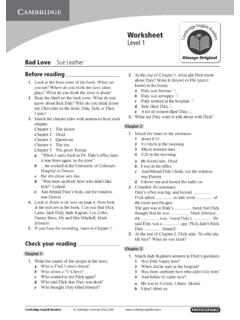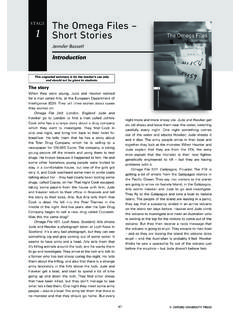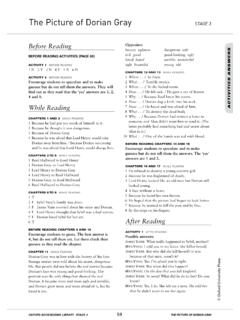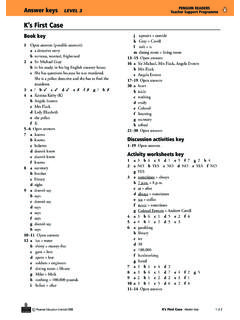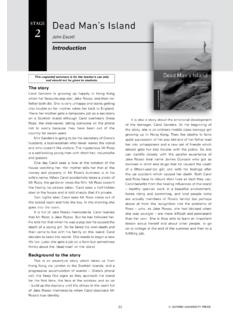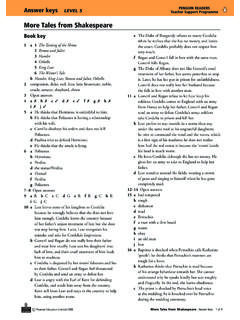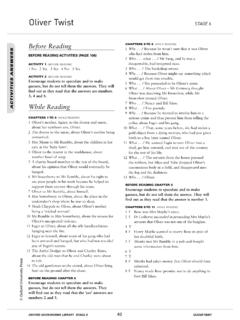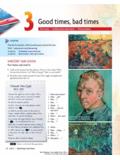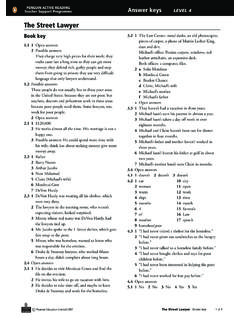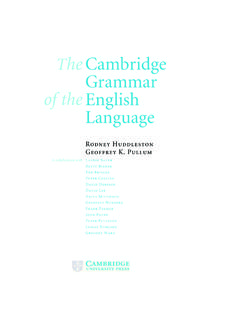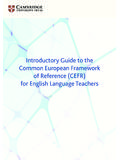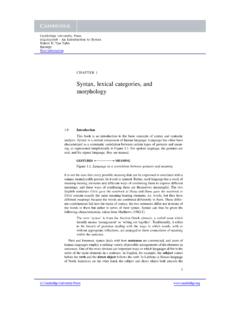Transcription of Oxford English Grammar Course
1 Oxford English Grammar Course BASIC-LEVEL TEACHERS' NOTES. INTRODUCTION. Purpose of the teachers' notes The exercises in a book of this kind will not of Course guarantee faultless speech or writing by learners nothing will. But such exercises can help to make students more aware of the correct formation and use of key structures, and thus reduce the number of errors in their production. Teachers will often wish to supplement the printed exercises with additional practice, particularly with the kind of personalised communicative practice that can help to bridge the gap between controlled classroom work and accurate spontaneous use of a structure.
2 The following notes contain some lesson-by-lesson suggestions for practice of this kind, as well as suggestions for out-of-class work. Teachers will certainly be able to add further activities based on their own thinking and experience. They will also find valuable ideas in the various books that have been written specifically to offer material for Grammar practice for instance Penny Ur's Grammar Practice Activities (Cambridge University Press 2009). Types of activity Some of the exercises suggested in these notes will need a little preliminary work by the teacher; others can be done with no preparation. Many of them involve pair work, group work or movement in the classroom.
3 This kind of work is essential if students are to get enough practice to carry over what they have learnt into fluent production; nobody gets very much practice if students speak one at a time in turn. However, students from some educational cultures may not be used to this element of relative freedom, especially where exercises involve moving around in the classroom. They may need to be introduced to this kind of work slowly, starting with simple short activities in pairs. Some exercises involve mime (which can provide very effective cues for speech), or other kinds of low-level dramatisation. Some students enjoy this kind of activity; others may be self-conscious about having the spotlight on themselves, so to speak; or they may simply get impatient with activities involving acting or miming, preferring real communication to role communication'.
4 Other exercise-types that may be unfamiliar and meet with resistance for cultural reasons are those that involve exchanging personal information with other students or the teacher; and even where there is no cultural barrier, not all students like talking about themselves in public. It's important to make sure that a class is offered a balanced diet that offers something for everybody, and to avoid pressurising students who are really unwilling to participate in one or other kind of activity. Where individuals or groups are asked to produce something (for example a mime or a mini-report) for the rest of the class, it is good to start with confident students, but one should avoid starting with the best (this can discourage the others).
5 Note that some activity types are useful for practising more than one point of Grammar , so there is occasional repetition in what follows. Oxford English Grammar Course Basic Michael Swan and Catherine Walter 2012. Using the presentation pages The presentation pages that open each Section of the book generally contain varied examples of the structures that will be dealt with in the following pages, often in the form of short texts, quotations, advertisements, cartoons etc. These are simply intended as undemanding reading matter for students, which will help to introduce the structures and perhaps fix them in students' minds. They are not meant as exercise material.
6 They can of Course be exploited in this way if teachers wish, but we think there is an important place in language work for no-hassle' reading and listening. Cartoons can be problematic, especially with students from backgrounds with different approaches to humour from European cultures: the jokes may sometimes need explanation by the teacher, and may occasionally simply not get across at all. However, cartoon captions can also constitute very direct and memorable illustrations of one or other point of Grammar , and we feel they are well worth including for this reason. Internet exercises Some exercises invite students to use an internet search engine such as Google for examples of the structures being practised.
7 It may be necessary to remind them to enclose the search items in double quotation marks: . Note that an internet search can sometimes be made difficult or impossible by the existence of a current popular reference containing the relevant structure which swamps the net. At the time of writing, for instance, if one searches for sentences beginning The only time I , most of the hits are identical quotations from the same song. It is also worth bearing in mind that English - language internet material will be in British, American and other varieties of English , and will include non-standard usage as well as postings by non-native speakers whose English may contain errors.
8 The language notes In the language notes' provided for some of the lessons, we mention typical problems that students may have with certain structures, often because of cross- language differences. We hope that these may be useful to less experienced teachers, especially those who are teaching students with whose languages they are not familiar. More detailed information about the problems which speakers of particular languages may have with English can be found in Learner English , edited by Michael Swan and Bernard Smith (Cambridge University Press 2001). Oxford English Grammar Course Basic Michael Swan and Catherine Walter 2012. Section 1 be and have page 1.
9 language notes If you are teaching students with whose language (s) you are not familiar, note that the apparently simple verbs be and have may not be straightforward for your students. (See notes on the following pages.). The Grammar of have is complicated (there are uses with or without do, with or without got, with or without progressives). With lower-level students, it may be better to postpone some aspects ( got-forms) until later. Pronunciation: the unstressed forms of am, are, was, were, have, has, had and there (in there is) can be difficult for some students to hear. The CD-ROM exercises will help with this. possible further activities Quotations These are simply intended for introductory reading.
10 However, if you want to base an activity on them for more advanced students, find some more quotations containing be, have, there is from a quotations website (to find some, type quotations into an internet search engine). Cut the quotations in half, distribute the halves round the class, and get students to walk round saying (not showing) their halves to each other in order to match up the halves. When they've done this, they read out their completed quotations, vote for their favourite quotation, and perhaps write them out and put them up on the classroom wall / notice board. pages 2 3. language notes Not all languages have a direct parallel to English be, used to connect a subject to a description or definition.
